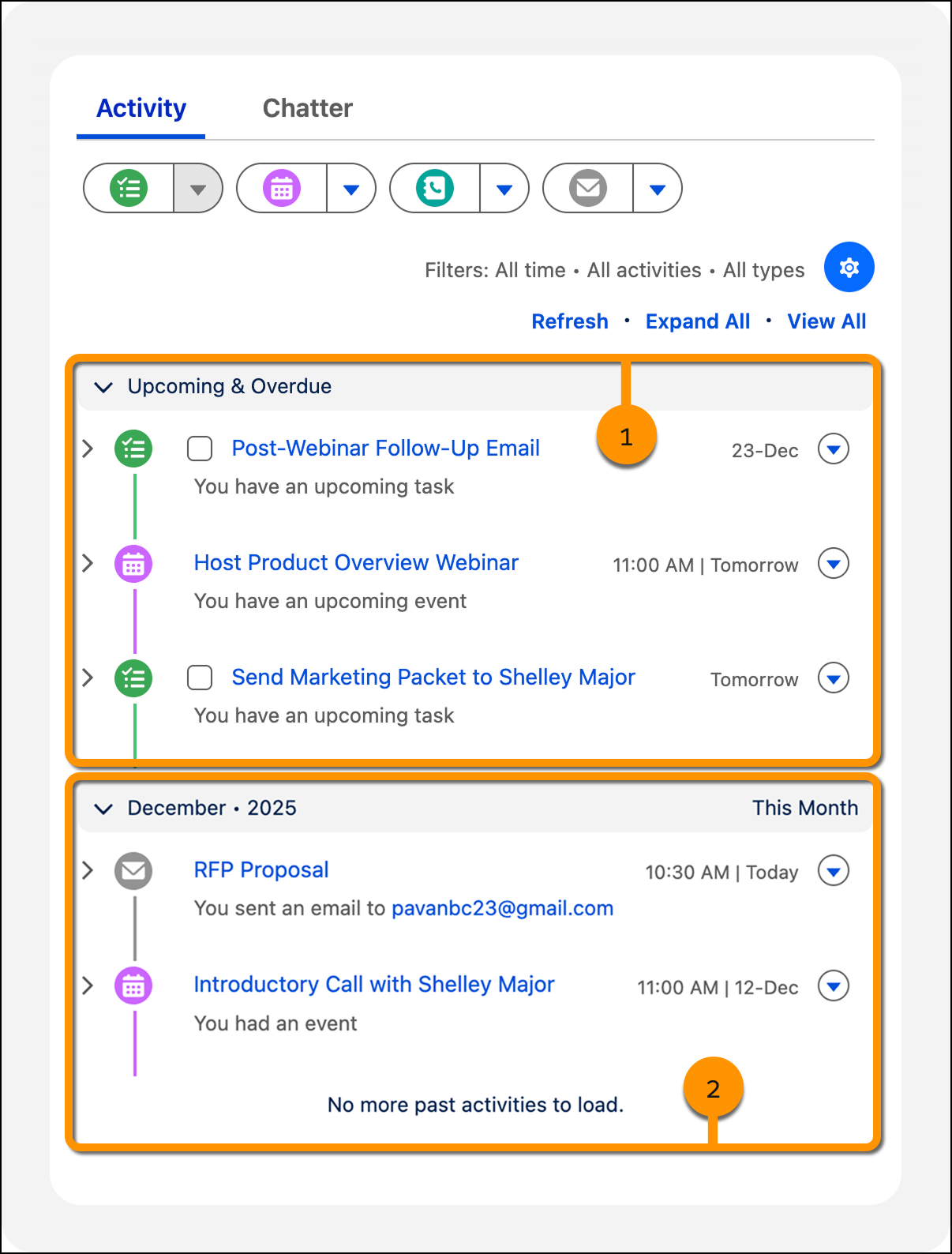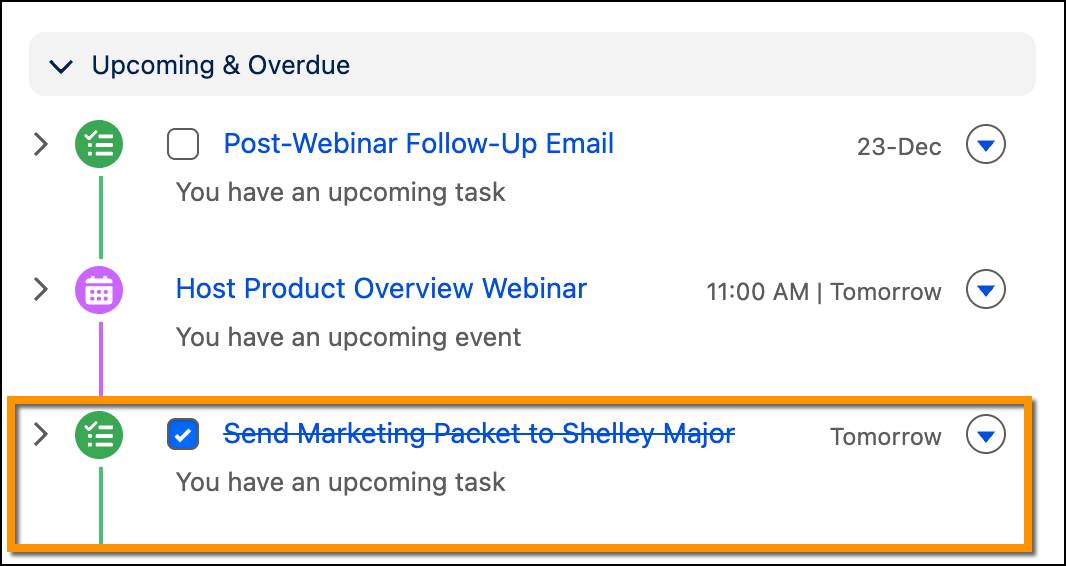Help Your Reps Use Activities
Learning Objectives
After completing this unit, you’ll be able to:
- Identify activity features that keep the sales process moving forward.
- Understand how the activity timeline helps your reps sell better.
- Determine which activity customizations help your reps most.
Keep Reps Productive Using Activities
Activities are the events and tasks that your sales reps manage in Salesforce. Lightning Experience helps reps get prepared for any meeting and know which task is the highest priority right now.
Track Meetings and Tasks Together
Remember those new sales reps, Erin and Lance? You met them in the Path & Workspaces module. They want to track meetings and tasks together in lists and reports to stay on top of their leads, contacts, opportunities, accounts, and campaigns.

It’s easy. Here are the places where they can do that.
Where |
What’s good to know |
|---|---|
On Home pages |
|
In Kanban view |
A yellow triangle on an opportunity indicates that the deal has no scheduled meetings or tasks. To get the deal moving, click the triangle and create an activity. |
On the activity timeline |
Your reps see their open tasks, scheduled meetings, and past activity on an opportunity, a lead, an account, or a contact. |
On activities reports |
Sales reps and managers run various reports to get insight into the progress and history of accounts and deals. If you’ve enabled Shared Activities, reps and managers can run certain standard or custom reports that show details about events, tasks, calls, and emails. The reports also show details about related contacts, accounts, opportunities, and other associated records. |
Because Erin and Lance are focusing on leads today, they’re relying heavily on the activity timeline.

Erin’s working a lead now for Shelley Major. Here, Erin sees that she already called Shelley to introduce herself (1). Foot’s in the door now!
And in Upcoming & Overdue, Erin sees scheduled events and tasks to complete—to keep the lead process going (2). Here, we can see that Erin has a webinar to host, a follow-up call to make, and a marketing packet to send. Manageable, right?
Now that she put the marketing packet in the outbound mail tray, she checks off that task.

Pretty satisfying, as you’ll soon find out yourself! Let’s see what it’s like to create a few tasks and then mark them as complete.
Ready to Get Hands-on with Sales Cloud?
Launch your Trailhead Playground now to follow along and try out the steps in this module. To open your Trailhead Playground, scroll down to the hands-on challenge and click Launch. You also use the playground when it's time to complete the hands-on challenges.
- Click the App Launcher (
 ), then click Sales.
), then click Sales.
- From the navigation bar click Accounts, then choose the All Accounts list view.
- Click GenePoint.
- Click the New Task button (
 ).
).
- For Subject, enter
Review RFP for generator at new lab.
- For Due Date, choose a date next week.
- Click Save.
Great, now you won’t forget about that important request for proposal (RFP). While you’re on the GenePoint account, let’s make a task for an open opportunity.
- From the Opportunities related list, click GenePoint Lab Generators.
- Click New Task.
- For Subject, enter
Follow up with Tech VP to connect with Operations stakeholders.
- For Name, find and choose Edna Frank.
- Click Save.
Well done! This task is related to both the account and the contact, so it will be visible in the activity list on either record.
Now let’s pretend that we’ve finished reviewing the RFP, so it’s time to mark the task complete.
- From the navigation bar, click Accounts.
- Click GenePoint.
- Check Review RFP for generator at new lab.
Checking off tasks really is satisfying.
Relate Multiple Contacts to a Single Event or Task
Our Salesforce admin, Maria, learns from the sales manager, Lincoln, that it’s helpful for his reps to relate an event or a task to multiple contacts. That’s because events and tasks often apply to more than one contact.
You enable the Shared Activities feature to let your sales reps relate multiple contacts to a single event or task.
Before you enable Shared Activities, it’s good to be aware of the following things.
- Your reps can relate an event or task to up to 50 contacts. That event or task is then related to the contacts in the activity timeline, related lists, and reports.
- Each contact shows its related events and tasks under Open Activities and Activity History, alongside other contact details.
- When creating or editing an event or task, reps see the names of all contacts related to that activity, alongside other details.
- Confirm that the Name related list appears on the Task and Event object detail page layouts. If it isn't there, add it.
- Your reps designate one contact as the primary contact on the activity. If a rep deletes the primary contact, the next contact on the activity’s related list becomes the new primary contact.
- Worst-case scenario, expect Shared Activities to become available to your sales teams 48 hours after you enable it. But that’s only if you have lots of sales reps who track tons of activities. It’s more likely that Shared Activities becomes available much sooner than 48 hours. Regardless of the time it takes, your sales reps can continue their work in Salesforce during the enabling process.
With those considerations in mind, let’s enable Shared Activities.
- Click
 and click Setup. The Setup page opens in a new tab.
and click Setup. The Setup page opens in a new tab.
- In the Quick Find box, enter
Activity.
- Click Activity Settings.
- Check Allow Users to Relate Multiple Contacts to Tasks and Events.
- Click Submit.
- Close the Setup tab to return to the Sales app.
Your Trailhead Playground contains only a small amount of data so it should only take a few moments for the feature to become enabled. In a real org it might take up to 48 hours.
Let’s make one more task, and relate it to two people.
- From the navigation bar, click Accounts.
- Click GenePoint.
- From the opportunities related list, click GenePoint Standby Generator.
- Click New Task.
- For Subject, enter
Introduce installation partner.
- For Name, find and choose Edna Frank.
- For Name, find and choose Pat Stumuller.
Pat is from Pyramid Construction and will work with Edna on this project.
- Click Save.
That’s all there is to adding multiple contacts to an activity. The task will appear on the contact records for both Edna and Pat.
Track Relationships with People and the Businesses They Work With
Lincoln explains to Maria that some of the contacts his reps track in Salesforce do business with more than just one account. In the past, his reps created duplicate contacts for each account that their customers do business with. Not ideal. So Maria looks into the feature Contacts to Multiple Accounts. It sounds like this feature helps her sales teams relate contacts to multiple accounts—just what Lincoln wanted!
Maria’s well on her way to getting her reps on a higher level of productivity. In addition to her reps getting the activity timeline, Maria set up Salesforce to let her reps relate multiple contacts to an event or task. And her reps can now track relationships with their customers and the businesses they work with.
Resources
- External Link: Elevate Your Productivity with Activity Management
- Salesforce Help: Customization Options for Events and Calendars
- Salesforce Help: Contacts to Multiple Accounts